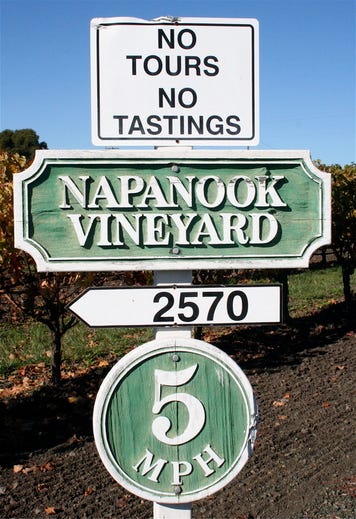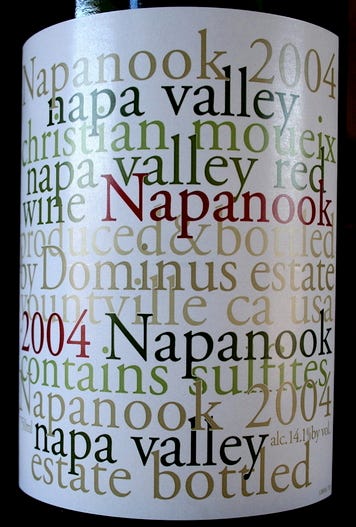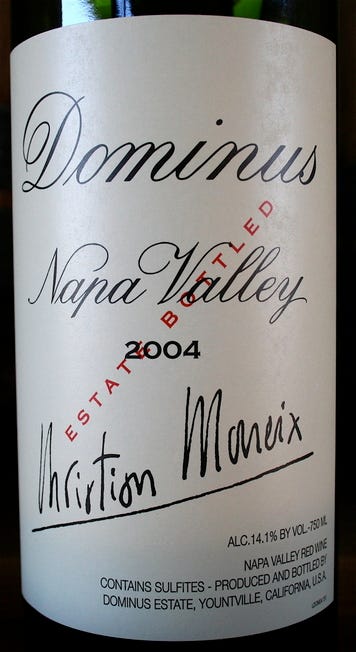The Wine You Love… from the Winery You Can’t Visit

As I write, I am a stone’s throw from America’s best restaurant (according to universal critics, The French Laundry). And no further, too, from my own favorite grill restaurant on the planet (Mustards Grill). Given these GPS hot points, you may well deduce: I am in Yountville, CA, at the midpoint of Napa Valley.
In fact, I am writing from a winery whose wines you love but whose facility you may never visit, thanks to county decisions and regulations made a long time ago in a galaxy far away.
In short: I am at Dominus Estate, making an official Press visit so that I may report back to would-be consumers of this estate’s great wines what is going on behind closed doors.
They’re not just “closed doors” – they’re rock walls! The entire structure is covered in a cage filled with rocks trucked in from nearby American Canyon. More on this architectural achievement later in the story.
For the record – and let’s get this bit of history out of the way now – Yountville (pronounced YAHNT-VIL) is named after prospector, land-lover and gad-about George Yount, who planted the first vines in Napa Valley, where Dominus is now perched, some 160 years ago.
Why I live where I live. Part 1. Vineyards out front of Dominus.
Dominus Estate is the brainchild of Pomerol winemaker Christian Moueix, whom I met (at Mustards Grill, of all places) last winter. If you are into wine, you will know Christian’s most famous label – Pétrus, a gorgeous Bordeaux from Pomerol that sells for $3,500 a bottle as a pre-arrival, which is three years before you can even take possession of it! (Kind of makes Dominus look like a bargain.)
Why I live where I live. Part 2. Vineyards out front of Dominus.
Christian’s family owns and operates more than ten chateaux (wineries) in Bordeaux, most of them in Pomerol and most of them making Merlot-based wines, not Cabernet, which is Dominus’ strong playing card.
Cabernet vines out the back of the building. Note: the vines that start to march up the Mayacamas hillside do not belong to Dominus.
Christian fell in love with our valley while studying at U.C. Davis in the late 1960s. After years of searching for an ideal vineyard, he entered into a joint venture in 1982 with the two daughters of winemaker John Daniel – Robin Lail and Marcia Smith, owners of Napanook Vineyard, which they had inherited from their father.
At that point, Christian became the “second high profile Frenchman in Napa Valley,” after the much-ballyhooed arrival of Baron Philippe de Rothschild, who had partnered with Robert Mondavi to create Opus One in 1979.
The property that Christian took over was planted exclusively on St. George rootstock (favored in the 70s) and was trained in the “goblet” fashion, (also called head-pruned), which encouraged the vines to grow like small bushes. Christian found this had an adverse effect on grapes planted in sunny, hot Yountville; grape clusters were often shrouded in shoots, or canes, which prevented sunlight and air from reaching internal, dangling clusters. In effect, grapes on the inside of the bush ripened at a much slower rate (if at all) than clusters on the outer edge.
What part of this are you not getting so far….? This place is Paradise!
Over the next dozen, or so, years, Christian and his small band of about 10 vineyard hands, repossessed, repackaged and replanted the property. Today there are about 100 acres replanted on six different kinds of rootstock, all grown on a double canopy trellis. In addition to Cabernet Sauvignon, Dominus now grows Cabernet Franc, Petit Verdot and Merlot, according to Boris Chamby, Dominus winemaker. These varieties are the classic grapes of Bordeaux.
Winemaker Boris Champy, whose family has vineyard holdings in Champagne. Boris is leaving Dominus to become winemaker at Maison Louis Latour, in Burgundy.
Everyone at Dominus with whom I spoke for this story echoed Christian’s thematic overview of winemaking: “Wine is made in the vineyard.”
And you see it for yourself when you visit the property (if you’re lucky enough to ever get the chance; HINT: become a wine distributor, wine merchant, or wine writer and you just might get an invitation). At other wineries, they hustle you into the fermenting room, or chai (barrel-ageing room), or tasting room, to tell you their winemaking story; at Dominus, Boris first took me out into the vineyard where we spent 40 minutes in the broiling sun, looking at vines and soil.
Although Dominus doesn’t practice textbook “Biodynamic,” or “Organic,” farming, intervention is minimal and common sense, not chemicals, prevails. There are 50 birdhouses – “one every two acres,” Boris told me – for bluebirds, which are inveterate insect-eaters. They wing through the vineyard destroying crop predators. As well, no herbicides are used, and no fertilizer is applied to the soil, only compost.
While Dominus could likely be certified Organic, or Biodynamic, good sources tell me that Christian is so tired of all the laws, regulations and rules that must be met on his home turf in Bordeaux, that he doesn’t want to get into the same level of regulated minutia here in America. He’ll walk the near-organic walk – just won’t sign up to be over-regulated to do so.
There are three types of soil on the Dominus estate – a gravelly/volcanic block, a heavy clay patch and a loamy block. For the most part, only the heavily compacted clay soil is irrigated because the roots of the vines can’t get below four-feet in depth.
“Everywhere else on the estate – most of our 100 acres – are dry-farmed,” says Boris, meaning NO water is added to keep the vines happy. They have to fight for their survival through droughts and lousy weather times.
This is not new in the world of wine production; many regions in France prohibit the use of irrigation altogether. Chateauneuf-du-Pape, in the southern Rhone, for example, has prohibitions against irrigating. But it is very un-American to dry-farm; most wineries in Napa Valley rely on drip-irrigation to keep their vines happy and in harmony. (It is often said in wine-making circles that “stressed vines produce better wines,” so vines that must send their roots deep down into the soil for water, are likely to pick up micronutrients and flavors from way down there, too.)
I’m no mathematician, but four types of grapes (Cabernet Sauvignon, Cab Franc, Petit Verdot, Merlot) x three types of soil (gravelly/volcanic, heavy clay, and loam) leads to more permutations and combinations than the Republicans have candidates to consider.
“At Dominus, we overcome this complexity by having 60 different-sized stainless steel fermenting tanks,” says Boris, explaining how they manage production. “We want to optimize every single grape on the estate; Cabernet will ripen at a different time than Merlot, and even among Cabernet vines, grapes planted on different blocks will mature at different times.”
So, in order to optimize maturation in the field (“it’s all about the vineyard – not interventions you may make in the winery”), grapes are harvested by block and by sub-division of block. Hence every grape is given its fair day in court – is permitted (even enabled) to reach its optimum level of ripeness before being crushed and fermented with grapes of the same mini-block.
Contrast this to many wineries where ALL the grapes are picked AT THE SAME TIME from a HUGE tract and processed AT THE SAME TIME in the SAME vat.
At Dominus, there is virtual micro-control of small blocks, which are picked at different times from the rest of the vineyard, fermented separately, and once vinified, added back in to a master, blended beverage.
The second-label of this property is Napanook, honoring the name given the vineyard by George Yount. The primary, or first, label is Dominus.
I asked Tod Mostero, who has been technical director but who becomes winemaker at the end of this month, what are the differences between Napanook and Dominus.
“Napanook is aged in 20 per cent new oak for 12 to 14 months and will age 10 to 15 years. About 5,000 cases are made annually and the wine is priced at about $40.”
“Dominus is aged in 40 percent new oak for 18 months and has the ability to age gracefully for 20-15+ years.”
Tod, who is taking the reigns over from Boris (who is heading out to become a winemaker in Burgundy), says that he recently tasted the 1987 Dominus of which there are very few bottles left in private cellars and that at 20 years of age “it is still a baby. The wine has at least another 15 years to show off – it’s gorgeous now but will get even better with time.”
Dominus is called “The Stealth Winery” by locals – and you can see why. Even up close, the low, rock-encrusted winery is barely visible.
The winery, just off Highway 29, is a two-story, flat, elongated building, designed by the Pritzker Prize-winning Swiss design team Herzog and de Meuron. They are best known for designing the Tate Modern, in London, and for the de Young Museum in San Francisco. Their first project in the US was Dominus and today remains their only building in Napa Valley.
The winery’s exterior is made of “gabions” which are rectangular, wire-fenced cages that are filled with grey basalt rocks; the rocks act like a skin on the building, protecting the interior from light and heat.
You’re likely to hear of Herzog and de Meuron over the next 12 months, too. They designed the Olympic Stadium in Beijing for the 2008 summer Olympics.
The winery is a sort of drive-through experience; note the exterior cages, or gabions, filled with rocks. Small deliveries of whole cluster grapes can be driven into the heart of the building through two major portals such as the one shown here.
I asked Boris and Tod if they agree with a theory that floats in Napa Valley – that the wines of French winemakers here somehow taste “French, or more Bordeaux-like, than the wines produced by American-born winemakers. I was thinking of Bernard Portet, winemaker at Clos du Val in the Stag’s Leap Wine District, who makes a delicious, balanced, thoroughly enjoyable Cabernet that tastes more Bordeaux-like than his neighbor’s wines.
“At other wineries in Napa Valley, they spend much of their time worrying about their barrels, about ageing their wines, about the process of making the wine. That is the American way,” say Boris and Tod.
“Here, at Dominus – and I am sure they do the same thing at Clos du Val – we start making wine in the vines and we stay in the vines. That is where great wine is made: in the vineyards. You cannot make a great wine, or a balanced wine, if you do not have great fruit to work with. Maybe that’s a French thing,” they theorize.
Winemaker Boris Champy, left, is leaving Dominus, and winemaker Tod Mostero, right, has come on board to replace him.
Talk about meticulous fruit; because there is so much dust on the grapes in the dry days of September and October, starting back in 1990, Christian told his winemaker team to start hand-washing ALL the grapes as they were picked, before being crushed.
It’s a little known fact that this practice has actually caught on a few other Napa Valley wineries. At Nickel & Nickel, for example, they have been spraying grapes as they come in off the field for the last five harvests, according to winery spokesperson Mary Grace. (I asked how they dry the grapes so that excess water doesn’t dilute the juice; she says they use air driers, a sort of variation of those hand-driers you find in commercial bathrooms. I trust they work better than those! Otherwise, I can see a line of field workers having to dry off the air-blown grapes on the front and back of their trowsers!)
But Wait… There’s More!
The chai, or barrel-ageing room, at Dominus holds between 450 and 500 barrels.
I asked to sample the current release of Napanook and Dominus while at the winery. Here are my tasting notes. And PAY ATTENTION! Because this is as close to the winery as you are going to come. You get to taste the labor of love – you just can’t ever come to the place where all the heavy lifting is done!

2004 Napanook
Dark fruit and vanilla on the nose. A harmonious blend of Asian spices, sandalwood, dark ripe fruit all combined seamlessly, elegantly. This wine has a lovely texture, a gorgeous weight in the mouth. Totally food friendly, even though a new release. Elegant. You would never guess that this wine is pushing 14 percent alcohol. Retails for about $40. 92 points.

2004 Dominus
On the nose there are whiffs of pitch and tar, organic earth and burnt mesquite. This wine is more minerally and earthy than the Napanook, and it has even darker ripe fruit. Also, there is a floral component that is not evident in the Napanook. A hint of lavender about three-quarters of the way through the swallow and a black pepper finish.
Retails for about $110. 93 points.
In case you don’t know how to read (this story) or take NO for an answer, you may still wish to plan a visit Dominus Estate. Although you cannot reach your goal (this is NOT the castle in the Rocky Horror Picture Show – they won’t let you in!), here’s what you’ll need to know:
Dominus is at 2570 Napanook Rd., Yountville, CA 94599 and there are NO TOURS, NO APPOINTMENTS AND YOU ARE NOT WELCOME. But the wine is glorious so go find it at a neighborhood wine store. Tel: (707) 944-8954.

